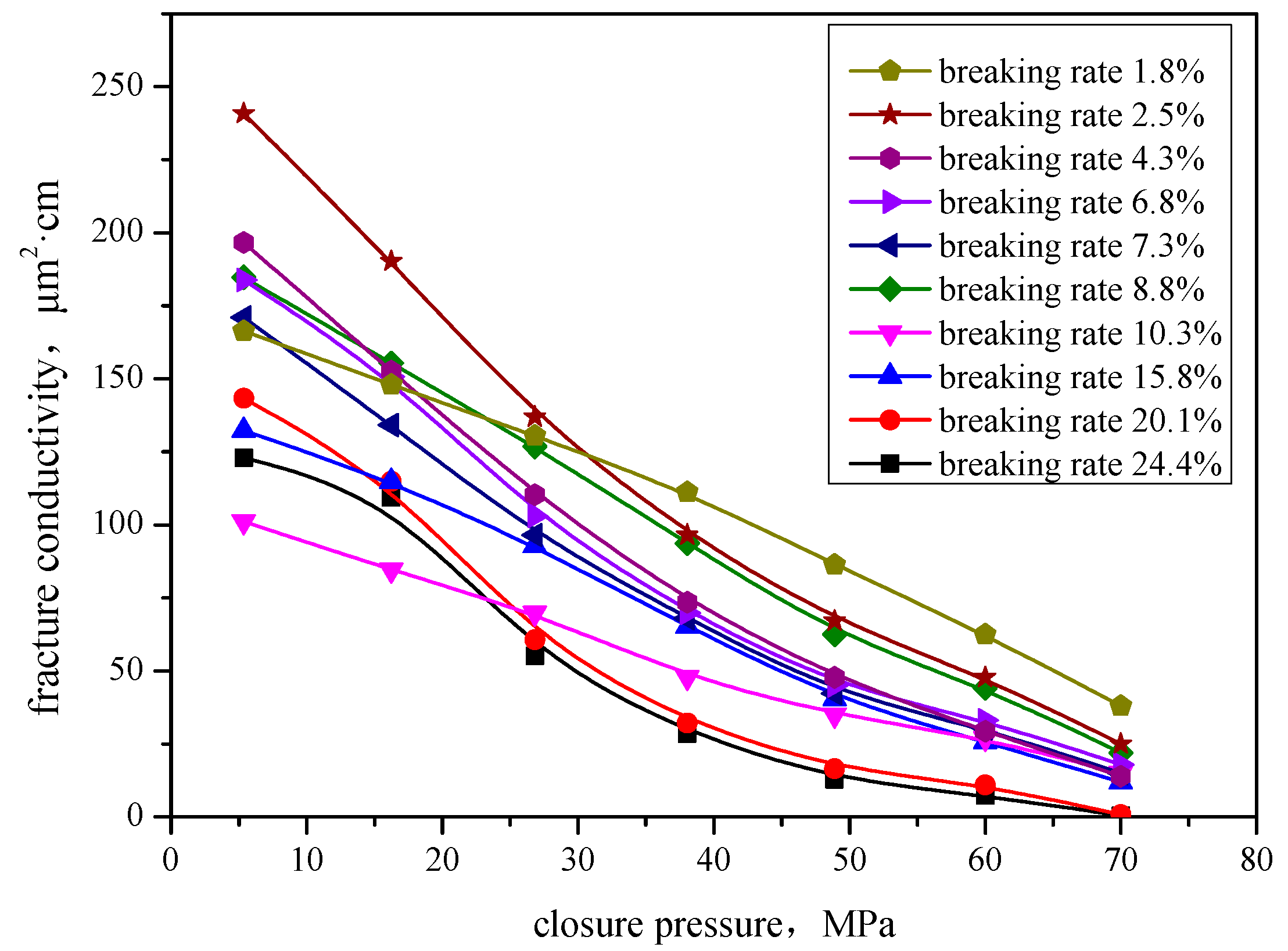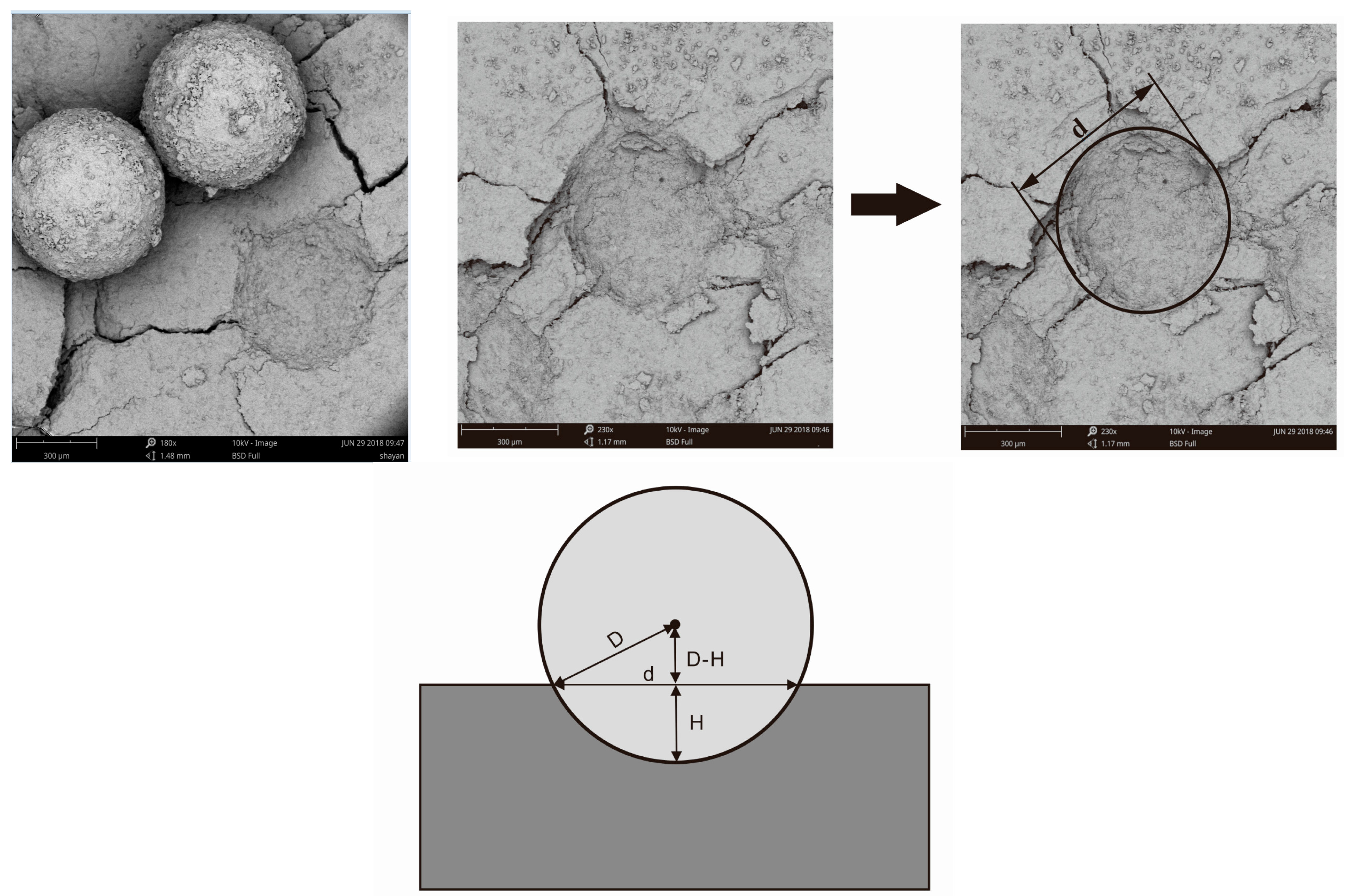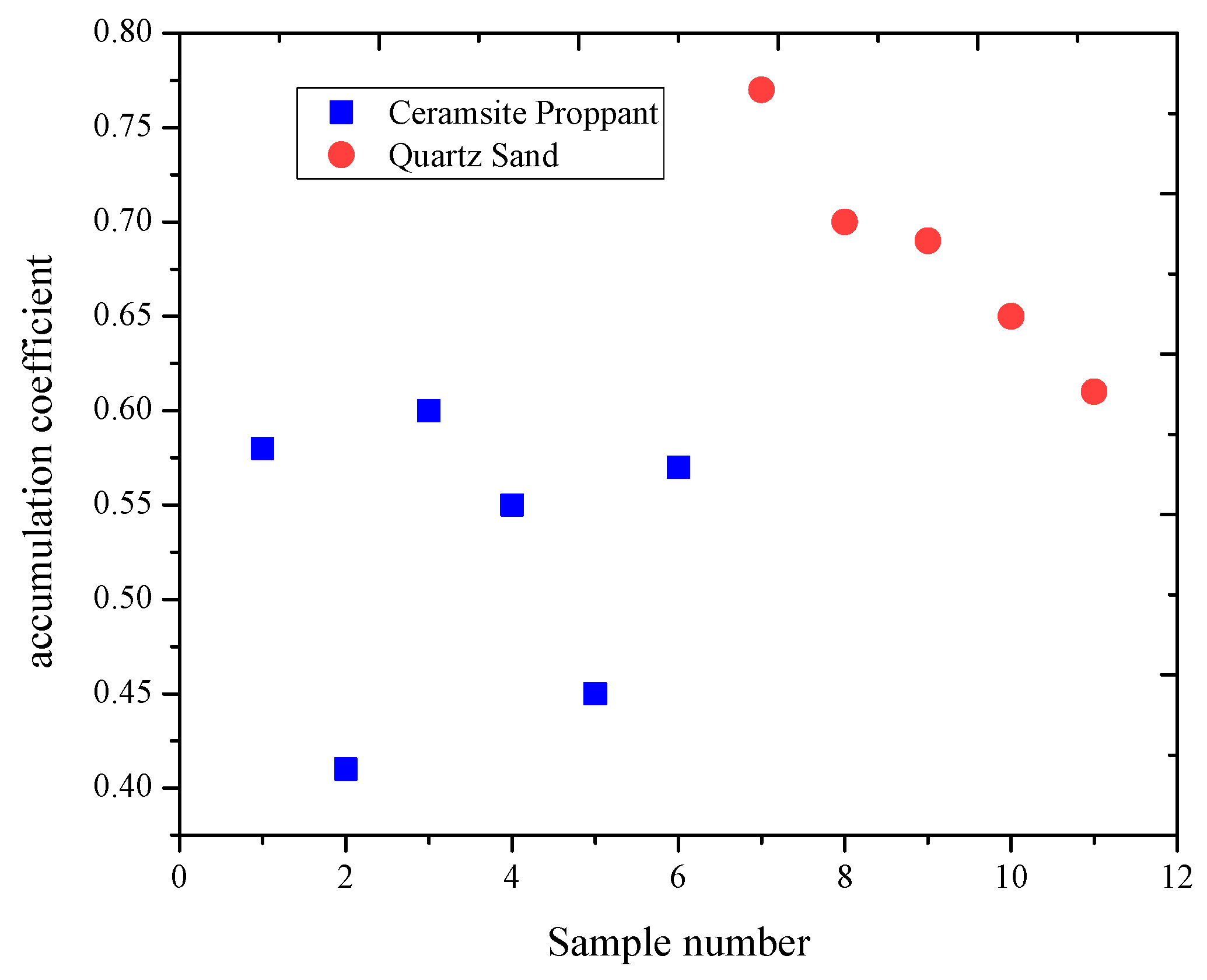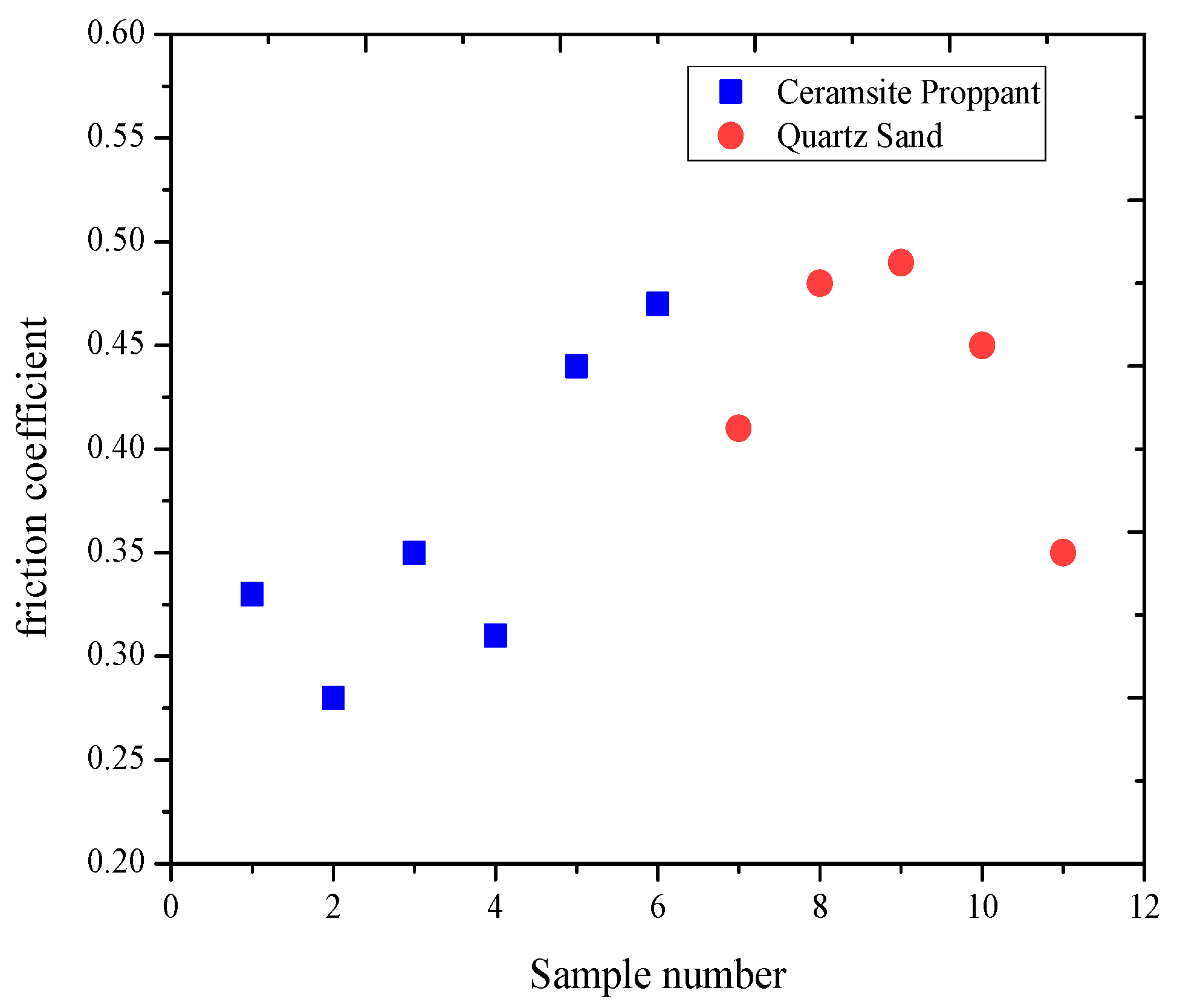The Evaluation Method and Performance Requirements of Quartz Sand for Shale Gas Fracturing
Abstract
:1. Introduction
2. Data and Methods
3. Results and Discussion
3.1. Particle Size
3.2. Turbidity
3.3. Density
3.4. Breaking Rate
3.5. Embedding Degree
3.6. Accumulation Coefficient
3.7. Friction Coefficient
3.8. Application
4. Conclusions
- (1)
- At present, there is no recognized industry standard for quartz sand for shale gas fracturing. Instead, the evaluation methods and performance requirements of quartz sand for shale gas fracturing mainly refer to the current national, oil and gas industry, and enterprise standards for sandstone reservoirs and thus cannot be fully applied to shale gas reservoirs.
- (2)
- Based on on-site production data, laboratory evaluation, and product statistical analysis, the performance indices suitable for shale gas fracturing proppants are finally determined. Quartz sand used for shale gas fracturing should be increased by five particle sizes, turbidity value should not be higher than 250 FTU, apparent density should not be higher than 2.75 g/cm3, breaking rate should not exceed 18%, and proppant embedding should be less than 0.15. The accumulation coefficient should be less than 0.8, and the friction coefficient should be less than 0.5.
- (3)
- The quartz sand in a single well in shale gas fracturing increased from 20–30% to more than 60–70%. Relevant research results can provide assurance and support for the early laboratory selection and on-site quality control of quartz sand used in shale gas fracturing, which is of great significance to promote the localization of quartz sand sources and reduce the investment cost of fracturing.
Author Contributions
Funding
Data Availability Statement
Conflicts of Interest
References
- Montgomery, C.T.; Smith, M.B. Hydraulic Fracturing: History of an Enduring Technology. J. Pet. Technol. 2010, 62, 26–40. [Google Scholar] [CrossRef]
- Figueiredo, B.; Tsang, C.F.; Rutqvist, J.; Niemi, A. Study of hydraulic fracturing processes in shale formations with complex geological settings. J. Pet. Sci. Eng. 2018, 152, 361–374. [Google Scholar] [CrossRef]
- Wang, Y.; Li, X.; Zhang, Y.X.; Wu, Y.S.; Zheng, B. Gas shale hydraulic fracturing: A numerical investigation of the fracturing network evolution in the Silurian Longmaxi formation in the southeast of Sichuan Basin, China, using a coupled FSD approach. Environ. Earth Sci. 2016, 75, 1093. [Google Scholar] [CrossRef]
- Li, Q.; Li, Q.; Cao, H.; Wu, J.; Wang, F.; Wang, Y. The Crack Propagation Behaviour of CO2 Fracturing Fluid in Unconventional Low Permeability Reservoirs: Factor Analysis and Mechanism Revelation. Processes 2025, 13, 159. [Google Scholar] [CrossRef]
- Li, Q.; Li, Q.; Wu, J.; Li, X.; Li, H.; Cheng, Y. Wellhead Stability During Development Process of Hydrate Reservoir in the Northern South China Sea: Evolution and Mechanism. Processes 2025, 13, 40. [Google Scholar] [CrossRef]
- Gao, Y.; Wang, D.; Chen, Z.; Li, Y.; Shen, S.; Li, D.; Liang, X.; Huang, Z. Numerical Simulation of Seepage in Shale Oil Reservoirs Under Hydraulic Fracturing: From Core-Scale Experiment to Reservoir-Scale Modeling. Energies 2024, 17, 5636. [Google Scholar] [CrossRef]
- Gao, Y.; Wang, X.; Jiang, H.; Ding, S. Numerically Coupled Thermo-Hydro-Mechanical Analyses of Ultra-Heavy Oil Reservoirs during the Micro-Fracturing Stage. Energies 2022, 15, 3677. [Google Scholar] [CrossRef]
- Fan, Y.; Peng, H.; Chen, G.; Peng, J.; Han, H.; Qin, Y.; Wang, L.; Liu, D. Experimental study of the influences of different factors on the acid-rock reaction rate of carbonate rocks. J. Energy Storage 2023, 63, 107064. [Google Scholar] [CrossRef]
- Peng, Y.; Li, Y.; Zhao, J. A Novel Approach to Simulate the Stress and Displacement Fields Induced by Hydraulic Fractures under Arbitrarily Distributed Inner Pressure. J. Nat. Gas Sci. Eng. 2016, 35, 1079–1087. [Google Scholar] [CrossRef]
- Zhao, J.; Peng, Y.; Li, Y.; Xiao, W. Analytical Model for Simulating and Analyzing the Influence of Interfacial Slip on Fracture Height Propagation in Shale Gas Layers. Environ. Earth Sci. 2015, 73, 5867–5875. [Google Scholar] [CrossRef]
- Patel, S.; Wilson, I.; Sreenivasan, H.; Naveen, P.; Gupta, P.; Krishna, S. Proppant transportation and placement in fractures by water and liquid nitrogen: A numerical simulation. Comput. Part. Mech. 2024, 11, 721–743. [Google Scholar] [CrossRef]
- Yang, M.; Economides, M.J. Natural Proppants for Hydraulic Fracture Production Optimization in Eagle Ford Shale. In Proceedings of the SPE Western Regional Meeting, Bakersfield, CA, USA, 23 March 2012. [Google Scholar] [CrossRef]
- Roostaei, M.; Nouri, A.; Fattahpour, V.; Chan, D. Numerical simulation of proppant transport in hydraulic fractures. J. Pet. Sci. Eng. 2018, 163, 119–138. [Google Scholar] [CrossRef]
- Li, H.; Wang, K.; Xie, J.; Li, Y.; Zhu, S. A new mathematical model to calculate sand-packed fracture conductivity. J. Nat. Gas Sci. Eng. 2016, 35, 567–582. [Google Scholar] [CrossRef]
- Jiang, C.; Jia, L.; Zhang, B.; He, Y.; Kirumba, G. Comparison of quartz sand, anthracite, shale and biological ceramsite for adsorptive removal of phosphorus from aqueous solution. J. Environ. Sci. (China) 2014, 26, 466–477. [Google Scholar] [CrossRef]
- Denis, P.; Radoslav, K. Investigation of the characteristics of an oil jet pump when using a group ground drive. J. Eng. Res. 2023, 11, 100004. [Google Scholar] [CrossRef]
- Yang, M.; Economides, M.J.; Wei, C.; Gao, C. Hydraulic Fracture Design Flaws-Proppant Selection. In Proceedings of the SPE Annual Technical Conference and Exhibition, New Orleans, LA, USA, 30 September–2 October 2013. [Google Scholar] [CrossRef]
- Mack, M.G.; Coker, C.E. Proppant Selection for Shale Reservoirs: Optimizing Conductivity, Proppant Transport and Cost. In Proceedings of the Unconventional Resources Conference—Canada, Calgary, AB, Canada, 5–7 November 2013. [Google Scholar]
- Hu, K.; Sun, J.; Wong, J.; Hall, B.E. Proppants Selection Based on Field Case Studies of Well Production Performance in the Bakken Shale Play. In Proceedings of the SPE Western North American and Rocky Mountain Joint Meeting, Denver, CO, USA, 16–18 April 2014. [Google Scholar] [CrossRef]
- Feng, L.; Mohammed, S.; Al-Muntasheri, G.A.; Chang, F.F. A comprehensive review on proppant technologies. Petroleum 2016, 2, 26–39. [Google Scholar] [CrossRef]
- Patel, P.S.; Robart, C.J.; Ruegamer, M.; Yang, A. Analysis of US Hydraulic Fracturing Fluid System and Proppant Trends. In Proceedings of the SPE Hydraulic Fracturing Technology Conference, The Woodlands, TX, USA, 3–5 February 2014. [Google Scholar] [CrossRef]
- Li, H.; Huang, B.; Zhao, X.; Wu, Z.; Jiao, X.; Han, X.; Sun, Z. Effects of fluid and proppant properties on proppant transport and distribution in horizontal hydraulic fractures of coal under true-triaxial stresses. J. Nat. Gas Sci. Eng. 2022, 108, 104795. [Google Scholar] [CrossRef]
- Bolintineanu, D.S.; Rao, R.R.; Lechman, J.B.; Romero, J.A.; Jove-Colon, C.F.; Quintana, E.C.; Bauer, S.J.; Ingraham, M.D. Simulations of the effects of proppant placement on the conductivity and mechanical stability of hydraulic fractures. Int. J. Rock Mech. Min. Sci. 2017, 100, 188–198. [Google Scholar] [CrossRef]
- Shamsi, M.M.M.; Nia, S.F.; Jessen, K. Dynamic conductivity of proppant-filled fractures. J. Pet. Sci. Eng. 2016, 151, 183–193. [Google Scholar] [CrossRef]
- Peng, Y.; Zhao, J.; Sepehrnoori, K.; Li, Y.; Li, Z. The Influences of Stress Level, Temperature, and Water Content on the Fitted Fractional Orders of Geomaterials. Mech. Time-Depend. Mater. 2020, 24, 221–232. [Google Scholar] [CrossRef]
- Maley, D.; Boyer, J.; O’neil, B.; Zhang, K. Surface modification of proppant to improve transport and placement. In Proceedings of the International Petroleum Technology Conference, Kuala Lumpur, Malaysia, 10–12 December 2014; OnePetro: Richardson, TX, USA, 2014. [Google Scholar]
- Han, J.; Pirogov, A.; Li, C.; Hurt, R.; Sookprasong, A.; Kim, J.M. Maximizing Productivity with Ultra-Lightweight Proppant in Unconventional Wells: Simulations and Field Cases. In Proceedings of the SPE Asia Pacific Hydraulic Fracturing Conference, Beijing, China, 24–26 August 2016. [Google Scholar]
- Hu, K.; Schmidt, A.; Barhaug, J.; Wong, J.; Tian, J.; Hall, B.E. Sand, Resin-Coated Sand or Ceramic Proppant? The Effect of Different Proppants on the Long-Term Production of Bakken Shale Wells. In Proceedings of the SPE Annual Technical Conference and Exhibition, Houston, TX, USA, 28–30 September 2015. [Google Scholar] [CrossRef]
- Ramlan, A.S.; Zin, R.M.; Bakar, N.F.A.; Othman, N.H. Recent progress on proppant laboratory testing method: Characterisation, conductivity, transportation, and erosivity. J. Pet. Sci. Eng. 2021, 205, 108871. [Google Scholar] [CrossRef]
- Paterniti, M.; Kundert, D.; Ramurthy, M.; Craig, D. Production Review of Current Stimulation Techniques in the Jonah Field. In Proceedings of the SPE Hydraulic Fracturing Technology Conference, The Woodlands, TX, USA, 3–5 February 2013. [Google Scholar]
- Fan, J.; Bailey, T.P.; Sun, Z.; Zhao, P.; Uher, C.; Yuan, F.; Zhao, M. Preparation and properties of ultra-low density proppants for use in hydraulic fracturing. J. Pet. Sci. Eng. 2017, 163, 100–109. [Google Scholar] [CrossRef]
- Li, H.; Lu, Y.; Zhou, L.; Han, S.; Gou, Y. A new constitutive model for calculating the loading-path dependent proppant deformation and damage analysis of fracture conductivity. J. Nat. Gas Sci. Eng. 2017, 46, 365–374. [Google Scholar] [CrossRef]
- Tasqué, J.E.; Vega, I.N.; Marco, S.; Raffo, P.A.; D’Accorso, N.B. Ultra-light weight proppant: Synthesis, characterization, and performance of new proppants. J. Nat. Gas Sci. Eng. 2021, 85, 103717. [Google Scholar] [CrossRef]
- Peng, H.; Fan, Y.; Peng, J.; Gao, X.; Gou, X.; Yin, Y. Experimental Evaluation and Application of New Size Proppant for Unconventional Reservoir Fracturing. Fresenius Environ. Bull. 2022, 31, 2898–2907. [Google Scholar]
- Deng, S.; Li, H.; Ma, G.; Huang, H.; Li, X. Simulation of shale–proppant interaction in hydraulic fracturing by the discrete element method. International J. Rock Mech. Min. Sci. 2014, 70, 219–228. [Google Scholar] [CrossRef]
- Peng, Y.; Zhao, J.; Sepehrnoori, K.; Li, Z. Fractional model for simulating the viscoelastic behavior of artificial fracture in shale gas. Eng. Fract. Mech. 2020, 228, 106892. [Google Scholar] [CrossRef]
- Peng, H.; Fan, Y.; Peng, J.; Han, H.; Gao, X.; Wang, L.; Gou, X.; Yin, Y.; Zhou, Y. Research and Application of a Proppant Transport Experimental Device for Complex Fractures in the Unconventional Reservoir. Geofluids 2022, 2022, 8356470. [Google Scholar] [CrossRef]
- Peng, H.; Li, W.; Liu, J.; Peng, J.; Han, H.; Liu, J.; Liu, D.; Yang, Z. Experimental Study for the Effects of Different Factors on the Sand-Carrying Capacity of Slickwater. Geofluids 2023, 2023, 7897165. [Google Scholar] [CrossRef]
- Peng, Y.; Zhao, J.; Sepehrnoori, K.; Li, Z.; Feng, X. Study of Delayed Creep Fracture Initiation and Propagation Based on Semi-analytical Fractional Model. Appl. Math. Model. 2019, 72, 700–715. [Google Scholar] [CrossRef]
- Yao, S.; Chang, C.; Hai, K. A review of experimental studies on the proppant settling in hydraulic fractures. J. Pet. Sci. Eng. 2022, 208, 109211. [Google Scholar] [CrossRef]
- Rivas, E.; Gracie, R. A Monolithic Coupled Hydraulic Fracture Model with Proppant Transport. Comput. Methods Appl. Mech. Eng. 2020, 372, 113361. [Google Scholar] [CrossRef]
- Yatin, S.; Islam, S.Z.; Hossain, M. Effect of Fracture Roughness on the Hydrodynamics of Proppant Transport in Hydraulic Fractures. J. Nat. Gas Sci. Eng. 2020, 80, 103401. [Google Scholar]
- Sahai, R.; Moghanloo, R.G. Proppant Transport in Complex Fracture Networks—A Review. J. Pet. Sci. Eng. 2019, 182, 106199. [Google Scholar] [CrossRef]
- Bello, A.; Ozoani, J.; Kuriashov, D. Proppant Transport in Hydraulic Fractures by Creating a Capillary Suspension. J. Pet. Sci. Eng. 2022, 208, 109508. [Google Scholar] [CrossRef]
- Aslannezhad, M.; Kalantariasl, A.; You, Z.; Iglauer, S.; Keshavarz, A. Micro-proppant placement in hydraulic and natural fracture stimulation in unconventional reservoirs: A review. Energy Rep. 2021, 7, 8997–9022. [Google Scholar] [CrossRef]
- Ahmad, F.A.; Miskimins, J.L. Proppant Transport and Behavior in Horizontal Wellbores Using Low Viscosity Fluids. In Proceedings of the SPE Hydraulic Fracturing Technology Conference and Exhibition, The Woodlands, TX, USA, 5–7 February 2019. [Google Scholar] [CrossRef]
- Yu, J.; Wang, J.; Li, Y.; El-Fayoumi, A.; Wu, R.; Liu, X.; Rijken, P.; Rathbun, A.P.; Elsworth, D. Permeability—Friction Relationships for Propped Fractures in Shale. Rock Mech. Rock Eng. 2023, 56, 9085–9098. [Google Scholar] [CrossRef]
- Zhao, J.; Peng, Y.; Li, Y.; Tian, Z. Applicable Conditions and Analytical Corrections of Plane Strain Assumption in the Simulation of Hydraulic Fracturing. Pet. Explor. Dev. 2017, 44, 454–461. [Google Scholar] [CrossRef]
- Feng, Y.C.; Ma, C.Y.; Deng, J.G.; Li, X.; Chu, M.; Hui, C.; Luo, Y. A comprehensive review of ultralow-weight proppant technology. Pet. Sci. 2021, 18, 807–826. [Google Scholar] [CrossRef]
- Isah, A.; Hiba, M.; Al-Azani, K.; Aljawad, M.S.; Mahmoud, M. A Comprehensive Review of Proppant Transport in Fractured Reservoirs: Experimental, Numerical, and Field Aspects. J. Nat. Gas Sci. Eng. 2021, 88, 103832. [Google Scholar] [CrossRef]
- Herskovits, R.; Fuss-Dezelic, T.; Shi, J.; Wilcox, C.; Todd, K. Sand and Ceramic Proppant Performance in Thin Layer/Monolayer Conditions Subjected to Cyclic Stress. In Proceedings of the SPE Eastern Regional Meeting, Canton, OH, USA, 13–15 September 2016. [Google Scholar] [CrossRef]
- Melcher, H.; Mayerhofer, M.; Agarwal, K.; Lolon, E.; Oduba, O.; Murphy, J.; Ellis, R.; Fiscus, K.; Shelley, R.; Weijers, L. Shale Frac Designs Move to Just-Good-Enough Proppant Economics. In Proceedings of the SPE Hydraulic Fracturing Technology Conference and Exhibition, The Woodlands, TX, USA, 4–6 February 2020. [Google Scholar] [CrossRef]
- Liao, Z.; Li, X.; Ge, L.; Yang, Z.; Zhu, J.; Xue, Q.; Wang, H. Lightweight proppants in unconventional oil and natural gas development: A review. Sustain. Mater. Technol. 2022, 33, e00484. [Google Scholar] [CrossRef]
- Jiang, T.; Zhang, S.; Wang, H.; Bian, X.; Zhong, G.; Wei, R.; Zhou, J.; Xiao, B.; Kao, J. Case Study: Dual Temporary Plugging & High Proppant Intensity Fracturing Stimulation Technique in Deep Shale Gas Play in Sichuan Basin, China. In Proceedings of the 56th U.S. Rock Mechanics/Geomechanics Symposium, Santa Fe, NM, USA, 26–29 June 2022. [Google Scholar] [CrossRef]
- Radwan, A. A Multifunctional Coated Proppant: A Review of Over 30 Field Trials in Low Permeability Formations. In Proceedings of the SPE Annual Technical Conference and Exhibition, San Antonio, TX, USA, 9–11 October 2017. [Google Scholar] [CrossRef]
- Palisch, T.; Duenckel, R.; Wilson, B. New Technology Yields Ultrahigh-Strength Proppant. SPE Prod. Oper. 2015, 30, 76–81. [Google Scholar] [CrossRef]
- Gorucu, S.E.; Shrivastava, V.; Nghiem, L.X. Numerical Simulation of Proppant Transport in Hydraulically Fractured Reservoirs. In Proceedings of the SPE Reservoir Simulation Conference, On-Demand, 26 October 2021; OnePetro: Richardson, TX, USA, 2021. SPE-203927-MS. [Google Scholar]
- Peng, H.; Yang, J.; Peng, J.; Pu, J.; Liu, Q.; Su, J.; Liu, J. Experimental Investigation of the Mechanism of Supercritical CO2 Interaction with Tight Sandstone. Front. Energy Res. 2022, 10, 984144. [Google Scholar] [CrossRef]
- Li, N.; Cheng, Q.; Gong, Z. Release kinetics of rare earth tracer from polymer-coated proppants for hydraulic fracture analysis. Geoenergy Sci. Eng. 2023, 227, 211782. [Google Scholar] [CrossRef]
- Fan, F.; Li, F.-X.; Tian, S.-C.; Sheng, M.; Khan, W.; Shi, A.-P.; Zhou, Y.; Xu, Q. Hydrophobic epoxy resin coated proppants with ultra-high self-suspension ability and enhanced liquid conductivity. Pet. Sci. 2021, 18, 1753–1759. [Google Scholar] [CrossRef]
- Tabatabaei, M.; Dahi Taleghani, A.; Cai, Y.; Santos, L.; Alem, N. Surface Modification of Proppant Using Hydrophobic Coating To Enhance Long-Term Production. SPE Prod. Oper. 2021, 36, 116–127. [Google Scholar] [CrossRef]
- Peng, H.; Yang, J.; Peng, J.; Han, H.; Gou, X.; Jia, Y. Source Analysis and Countermeasure Research of Sand Production after Hydraulic Fracturing in Tight Sandstone Gas Reservoir. Lithosphere 2022, 2022, 8342062. [Google Scholar] [CrossRef]
- Shaoul, J.R.; Park, J.; Langford, M. The Effect of Resin-Coated Proppant and Proppant Production on Convergent-Flow Skin in Horizontal Wells With Transverse Fractures. SPE Prod. Oper. 2020, 35, 214–230. [Google Scholar] [CrossRef]
- Peng, H.; Zhou, L.; Yang, J.; Peng, J.; Han, H.; Gou, X.; Wang, Z. Influence of Supercritical CO2 on the Formation Sensitivity of Tight Sandstone. Front. Energy Res. 2022, 10, 922941. [Google Scholar] [CrossRef]
- Guo, T.; Zhang, S.; Qu, Z.; Zhou, T.; Xiao, Y.; Gao, J. Experimental study of hydraulic fracturing for shale by stimulated reservoir volume. Fuel 2014, 128, 373–380. [Google Scholar] [CrossRef]
- Zou, C.; Dong, D.; Wang, Y.; Zou, C.; Dong, D.; Wang, Y.; Li, X.; Huang, J.; Wang, S.; Guan, Q.; et al. Shale gas in China: Characteristics, challenges and prospects (II). Pet. Explor. Dev. 2015, 43, 182–196. [Google Scholar] [CrossRef]
- Keshavarz, A.; Badalyan, A.; Carageorgos, T.; Bedrikovetsky, P.; Johnson, R. Graded proppant injection into coal seam gas and shale gas reservoirs for well stimulation. In Proceedings of the Spe European Formation Damage Conference & Exhibition, Budapest, Hungary, 3–5 June 2015; OnePetro: Budapest, Hungary, 2015. [Google Scholar] [CrossRef]
- ISO 13503-2:2006; The Evaluation Standards for Proppant Performance Abroad: Petroleum and Natural Gas Industries—Completion Fluids and Materials—Part 2: Measurement of Properties of Proppants Used in Hydraulic Fracturing and Gravel-Packing Operations. ISO: Geneva, Switzerland, 2006.
- SY/T 5108-2014; The Evaluation Standards for Proppant Performance in China: Methods for Testing Performance of Proppants for Hydraulic Fracturing and Gravel Packing. ChineseStandard.net: Beijing, China, 2014.
- Dahl, J.; Nguyen, P.; Dusterhoft, R.; Calvin, J.; Siddiqui, S. Application of micro-proppant to enhance well production in unconventional reservoirs: Laboratory and field results. In Proceedings of the SPE Western Regional Meeting, Garden Grove, CA, USA, 27–30 April 2015. [Google Scholar]
- Olmen, B.D.; Anschutz, D.A.; Brannon, H.D.; Stribling, K.M. Evolving Proppant Supply and Demand: The Implications on the Hydraulic Fracturing Industry. In Proceedings of the SPE Annual Technical Conference and Exhibition, Dallas, TX, USA, 24–26 September 2018. [Google Scholar] [CrossRef]
- Anschutz, D.; McGill, M.; Fleming, S.; Landis, C.; Cage, T. Turbidity in Frac Sand from Proximity Mines in the Permian Basin: Is it Detrimental to the Fracture System? In Proceedings of the SPE Hydraulic Fracturing Technology Conference and Exhibition. The Woodlands, TX, USA, 4–6 February 2025. [Google Scholar] [CrossRef]
- Tian, Y.; Zhou, F.; Aljawad, M.S.; Weijermars, R.; Wu, M.; Li, B. Laboratory Tests and Well Rate Models of Crushed Micro-Proppants to Improve Conductivity of Hydraulic Microfractures. In Proceedings of the International Petroleum Technology Conference, Riyadh, Saudi Arabia, 21–23 February 2022. [Google Scholar] [CrossRef]
- Benge, M.; Lu, Y.; Katende, A.; Rutqvist, J.; Crandall, D.; Haecker, A.; King, G.; Renk, J.B.; Radonjic, M.; Bunger, A. Connecting Geomechanical Properties with Potential for Proppant Embedment and Production Decline for the Emerging Caney Shale, Oklahoma. In Proceedings of the SPE/AAPG/SEG Unconventional Resources Technology Conference, Houston, TX, USA, 26–28 July 2021. [Google Scholar] [CrossRef]











| Experiments | ISO 13503-2:2006 [68] | SY/T 5108-2014 [69] | The Actual Combination with Shale Fracturing |
|---|---|---|---|
| Density | Volume density, apparent density, absolute density, and no technology indicators | The density does not change obviously with temperature and pressure | |
| Sphericity | Laboratory experiment determined by a chart method. Technology indicators: ceramsite particles ≥ 0.7 and quartz sand ≥ 0.6 | The sphericity of particles is a limited guide to engineering applications | |
| Sieving | Laboratory experiment and screen combination. Technology indicators: a specified mesh size ≥ 90% | During formation, the particle size of the proppant after pressure fracture is a key factor in the conductivity of the flow | |
| Acid solubility | Laboratory experiment, 12%HCl + 3%HF, where the acid is excessive. Technology indicators: ceramsite particles and quartz sand < 7% | 15% HCl is used in shale gas fracturing, and the acid is very little | |
| Turbidity | Laboratory experiment. Technology indicators: quartz sand and ceramsite particles ≤ 250 | Laboratory experiment. Technology indicators: quartz sand ≤ 150 and ceramsite particles ≤ 100 | During formation, particles from proppant fragmentation can lead to increased turbidity |
| Breaking rate | Single-axis laboratory experiment, where 10% is the grading basis | Single-axis laboratory experiment with no pore pressure, where 9% is the grading basis | Under the action of the formation of fluid, the fracture rate is lower than the experimental results of existing evaluation methods |
| Accumulation coefficient | There is no corresponding evaluation method for proppant movement status | With the low sand-carrying capacity of slickwater, the proppant accumulates in fractures to form a sand embankment, which gradually advances | |
| Friction coefficient | There is no corresponding evaluation method for proppant movement status | Proppant friction with fracture wall | |
| The Particle Size of Quartz Sand (Mesh) | 20/40 | 30/50 | 40/60 | 40/70 | 50/100 | 70/140 | 80/120 | 200/325 | 250/400 |
|---|---|---|---|---|---|---|---|---|---|
| The upper specification limit (μm) | 850 | 600 | 425 | 425 | 300 | 212 | 180 | 75 | 58 |
| The lower specification limit (μm) | 425 | 300 | 212 | 212 | 150 | 106 | 75 | 45 | 38 |
| Well Number | Well Segment (m) | Stage Length (m) | Total Hydrocarbon (%) | Organic Carbon Content (%) | Porosity (%) | Gas Production (m3/t) | Brittleness Index (%) |
|---|---|---|---|---|---|---|---|
| CNH26-X | 3450~4950 | 1500 | 24.2 | 3.2 | 5.1 | 6.4 | 57.0 |
| Well Number | Stages Designed (Stage) | Actual Stages (Stage) | Horizontal Stage Length (m) | Fracturing Stage Length (m) | Total Liquid Volume (m3) | Total Sand Volume (m3) | Average Single-Stage Liquid Volume (m3) | Average Single-Stage Sand Volume (t) |
|---|---|---|---|---|---|---|---|---|
| CNH26-X | 23 | 18 | 1500 | 1217 | 33600 | 2975 | 1867 | 165.26 |
Disclaimer/Publisher’s Note: The statements, opinions and data contained in all publications are solely those of the individual author(s) and contributor(s) and not of MDPI and/or the editor(s). MDPI and/or the editor(s) disclaim responsibility for any injury to people or property resulting from any ideas, methods, instructions or products referred to in the content. |
© 2025 by the authors. Licensee MDPI, Basel, Switzerland. This article is an open access article distributed under the terms and conditions of the Creative Commons Attribution (CC BY) license (https://creativecommons.org/licenses/by/4.0/).
Share and Cite
Peng, H.; Yang, J.; Liu, F.; Zhang, X.; Ning, F.; Peng, H.; Liu, Z.; Sun, J.; Cheng, W.; Cui, G.; et al. The Evaluation Method and Performance Requirements of Quartz Sand for Shale Gas Fracturing. Energies 2025, 18, 1979. https://doi.org/10.3390/en18081979
Peng H, Yang J, Liu F, Zhang X, Ning F, Peng H, Liu Z, Sun J, Cheng W, Cui G, et al. The Evaluation Method and Performance Requirements of Quartz Sand for Shale Gas Fracturing. Energies. 2025; 18(8):1979. https://doi.org/10.3390/en18081979
Chicago/Turabian StylePeng, Huan, Jian Yang, Fei Liu, Xiaofang Zhang, Fulong Ning, Hanxi Peng, Zhichao Liu, Jiaxin Sun, Wan Cheng, Guodong Cui, and et al. 2025. "The Evaluation Method and Performance Requirements of Quartz Sand for Shale Gas Fracturing" Energies 18, no. 8: 1979. https://doi.org/10.3390/en18081979
APA StylePeng, H., Yang, J., Liu, F., Zhang, X., Ning, F., Peng, H., Liu, Z., Sun, J., Cheng, W., Cui, G., & Shi, P. (2025). The Evaluation Method and Performance Requirements of Quartz Sand for Shale Gas Fracturing. Energies, 18(8), 1979. https://doi.org/10.3390/en18081979








